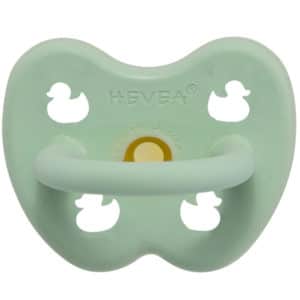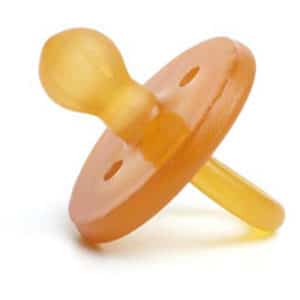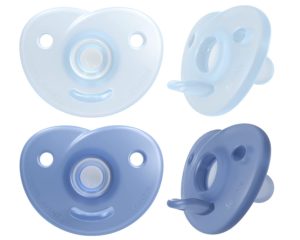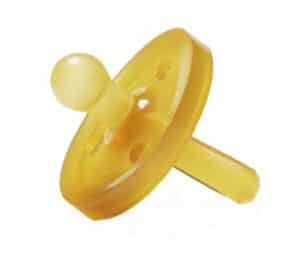If you’re in the market for a pacifier for your baby, it’s important to remember that it’s not only the nipple that they will suck on. For this reason, we prefer pacifiers that don’t have plastic shields. Here are some good options for non-toxic pacifiers made from single-piece silicone or natural rubber pacifiers without plastic.
Table of Contents
If you nurse your baby, chances are you’ve felt like a human pacifier at times. It makes sense, then, that if your baby is healthy and happy, you might be keen to unlatch from non-nutritive sucking and let an inert object do the heavy lifting.
I’ll leave the pacifier pros and cons debate to public health professionals, as every baby and every family is different. If you are going to use a soother, though, here are my recommendations for eco-friendly, non-toxic pacifiers.
Before my top picks, I offer some tips on what to watch out for when choosing a pacifier. And, because the nerd in me couldn’t resist, a bonus crash course on glow-in-the-dark chemistry!
What to watch out for when choosing a pacifier
There are some pretty obvious safety concerns when giving your baby a pacifier. Like any object your child uses unsupervised, pacifiers shouldn’t have small parts that are a choking hazard. Pacifiers should also be designed so they don’t obstruct breathing or cause any other type of mechanical injury.
If a pacifier is approved for sale in the U.S. with an ASTM label, it has been tested for mechanical safety. All of the soothers above comply with U.S. safety standards. Ideally, pacifiers also comply with more strict European Union safety standards and are approved by the American Dental Association.
All that aside, pacifiers pose less obvious risks, such as exposure to endocrine-disrupting chemicals and carcinogens.
Having parented both a puppy and an infant, I can confirm that both species explore the world with their mouths. And, because mouths are warm, moist spaces with thin membranes, chemicals are more likely to leach from pacifiers and be absorbed. Add to that the fact that babyhood is a time of rapid growth, and there’s a significant risk that exposure to toxic chemicals can adversely affect normal development.
Puppies and babies are also unlikely to use products like pacifiers exactly as manufacturers intend. So, even if a soother has a safe silicone or rubber nipple, your baby will inevitably mouth plastic parts such as the shield. In general, then, it’s best to minimize risk by choosing single-piece silicone or natural rubber pacifiers without plastic.
Things to avoid when choosing a soother
The most important things to watch out for when buying a soother include mechanical defects or damage and:
- PVC and other plastics – often made with phthalates and BPA or alternatives such as BPS and BPS that may be just as, if not more, unhealthy
- Synthetic latex – can contain carcinogenic nitrosamines and is derived from fossil fuels (always ensure a latex or rubber product is made entirely with natural latex)
- Synthetic dyes, fragrances, and other chemical treatments – soothers do not need to be vanilla scented or have a cute color or pattern.
The best materials for a pacifier
These days, most pacifiers are made with a plastic shield and food-grade or medical-grade silicone nipple. While high-quality silicone is inert and non-toxic, low-quality silicone may contain traces of lead, a toxic heavy metal.
In general, silicone pacifiers are more robust than natural rubber pacifiers. However, while silicone can last longer, pacifiers can become damaged and degrade. This happens faster with more use and more sterilization, especially in a dishwasher. If a silicone pacifier develops any cracks or tears replace it immediately as it can present a choking hazard. Manufacturers also recommend replacing silicone pacifiers after 4-6 weeks for hygiene purposes.
Silicone is also not as soft as latex, and it is synthetic and doesn’t biodegrade. So, while a good choice for a non-toxic pacifier, it’s not particularly eco-friendly overall.
Natural pacifier materials
Natural rubber is the best choice for a safe, non-toxic, eco-friendly pacifier. This rubber comes from the Hevea Brasiliensi tree and is a sustainable material. Rubberwood trees can be tapped for up to 25 years, during which they also help sequester carbon dioxide.
Natural rubber pacifiers are usually made without any chemical additives. Some pacifiers, including those made by Hevea, may contain small amounts of food-grade pigments. Because latex is a natural material, rubber pacifiers vary in color from a light orange/yellow to a darker amber shade.
Once a latex pacifier starts to get sticky and darker in color, this is usually a sign it needs replacing. Natural rubber relaxes after 6-8 weeks, whereupon it can start to become molded by a suckling baby. If they get too used to this tailor-made pacifier, they may not accept a new pacifier. As such, it’s best to replace natural rubber soothers in a timely manner.
Are glow-in-the-dark pacifiers safe?
For every parent who has scrambled for a pacifier in dim light, a self-illuminated pacifier seems like a godsend. But are glow-in-the-dark pacifiers safe? Great question! To get to the bottom of things, we have to know how manufacturers make pacifiers glow in the dark.
Why do things glow in the dark?
There are a few ways to make things glow in the dark, one of which is radioactivity. It’s extremely unlikely that any pacifier contains radioactive elements like tritium as this is highly dangerous. Any manufacturer foolish enough to use radioactive elements would quickly draw the attention of the CPSC or ASTM.
So, if that glowing pacifier isn’t radioactive, what makes it glow? In most cases, the answer is zinc sulfide or strontium aluminate. These compounds, known as phosphors, absorb ultraviolet light during the day and then slowly emit that absorbed energy at night.
Strontium aluminate is a newer type of phosphor and is increasingly common in glow-in-the-dark toys. This is because strontium aluminate has a much longer persistence than zinc sulfide. Persistence, in this instance, means that the phosphor emits light for a longer time after being energized.
To make glow-in-the-dark pacifiers, then, manufacturers mix one or both of these phosphors with compounds called activators. These increase the amount of glow given off by the phosphors and can also alter the color of the glow. The mixture is then added to plastic or silicon and the resulting material is molded into the pacifier shape.
Alright, but are glow-in-the-dark pacifiers safe?
As always, it’s not clear-cut whether pacifiers are safe if they glow in the dark.
First, the compounds are contained within the materials, rather than being painted on. This means there’s little chance of exposure to zinc sulfide or strontium aluminate from sucking on a pacifier. Even if some strontium aluminate did leach, it is inert, non-toxic, and present in negligible amounts that aren’t hazardous.
On the other hand, zinc sulfide can be toxic. Again, though, the dose makes the poison. Unless manufacturers have gone way overboard, there’s not enough zinc sulfide in a pacifier to pose a health risk.
Just to confuse things though, manufacturers use all kinds of activators when making these glow-in-the-dark products. And, as is often the way, they don’t list the chemicals they use during manufacture. Most commonly, zinc sulfide is mixed with copper or silver as an activator. One of the rarest rare-earth elements, called europium, is mixed with strontium aluminate to give that long-lasting glow.
Again, the amounts of copper, silver, or europium in a pacifier are so tiny that the risk is extremely low. If anything, the greater concern is how these elements are mined in the first place. Extraction of these metals is commonly linked to environmental pollution, child labor, and forced labor.
In conclusion, a pacifier is unlikely to pose a health hazard to your baby because it glows in the dark. The bigger risks will be its construction and any pacifier clips that pose a strangulation or choking hazard. As it stands, the only glow-in-the-dark pacifiers I’ve found are plastic, so they don’t make the LeafScore cut anyway!
The best non-toxic pacifiers: our top picks

Hevea pacifier
Highlights: Butterfly-shaped rounded or orthodontic pacifiers made with natural rubber and food-grade natural pigments.
- Offered in a variety of colors and patterns, all made using non-toxic food-grade pigments
- Rounded or orthodontic options available
- Completely biodegradable
- Smaller in size than some competitors, which may not fit every situation
Made in Malaysia from natural rubber, Hevea pacifiers are another affordable soother option. The company offers pacifiers in a variety of colors and patterns, created using natural and non-toxic food-grade pigments.
Hevea pacifiers are available in two sizes, newborn to 3 months and 3 months to 3 years (view here). The pacifiers are available with a rounded or orthodontic nipple. All are butterfly-shaped, with a smaller overall size compared to Ecopiggy and Natursutten.
Hevea runs an environmentally friendly office that reuses, recycles, and reduces waste. For instance, the company turns leftover packaging into postcards, business cards, in-store materials, and other items. Hevea also offers a recycling program for rubber pacifiers, upcycling these into innovative and new products!
The company makes its pacifiers in Malaysia to cut transport emissions. The packaging is made from FSC certified paper and is biodegradable. Even the clear window in the box is made from 100% biodegradable film.

Ecopiggy Ecopacifier
Highlights: Affordable, high-quality natural rubber pacifier – a top pick!
- No colors or chemicals added
- Made from natural rubber as a single piece
- Affordable option from a reputable company
- Natural rubber requires replacement every 6-8 weeks
The Ecopiggy Ecopacifier is a great choice for a non-toxic, eco-friendly soother. It is made with natural rubber as a single piece and is affordable, reputable, and robust. There are two sizes, one for newborns to 6 months and one for babies 6 months and older. This pacifier has a round nipple that mimics a natural nipple, helping to support ongoing breastfeeding.
The Ecopacifier is available with a rounded or orthodontic nipple. The latter encourages baby teeth to give way to adult teeth later. Neither style has a butterfly-shaped cutout. Instead, the pacifiers have a rounded shield that touches the baby’s nose to mimic contact while breastfeeding.
This pacifier has no colors or chemicals added and, like every natural rubber pacifier, will need replacing every 6-8 weeks. Over time, rubber ‘relaxes’, which means it can be molded by your baby. If it gets too molded, this can make it hard for a baby to get used to a fresh pacifier later.
This pacifier isn’t safe for the microwave or boiling and should instead be handwashed with warm soapy water. The pacifiers are made in Malaysia and then hand-inspected and packaged in the USA using recyclable cardboard.
Ecopiggy is a women-owned business based in Oregon. The company only makes eco-friendly products and deliberately manufactures the pacifiers in Malaysia to cut down on production-associated transport emissions.
You can also buy a budget-friendly 3-pack of the rounded pacifiers (view here) and orthodontic pacifiers (view here).

Philips AVENT BPA-Free Silicone Soothie Pacifier
Highlights: Possibly the best silicone-only soother available. Suitable for 0-3 months and 3-18 months. Dishwasher-safe, orthodontic design, and very affordable, but not biodegradable.
- Made from non-toxic medical grade silicone
- Offered at a very affordable price
- Dishwasher safe, and heat resistant enough to be boiled between uses
- Small handle may be difficult for babies to hold
- Silicone is neither biodegradable nor recyclable
Philips AVENT Silicone Soothie is a silicone-only pacifier, not just a plastic pacifier with a silicone nipple. The orthodontic design is approved by the American Dental Association and the pacifier has a space in the center where you can put your finger to help your baby learn to suckle. Compared to most soothers, this design has a smaller ‘handle’ or ‘knob’ for your baby to hold onto. For some babies, this might make the soother hard to hold.
The silicone is medical grade and non-toxic, and Soothies are made by a reputable company and offered at a very affordable price. Soothies are easy to clean and sterilize as they have a one-piece design and are dishwasher-safe. You can also put Soothies in a sterilizer or boil them between uses.
This soother is available in a softer style for 0-3 months and a slightly harder silicone for babies 3-18 months. For babies who aren’t yet teething, silicone can be hard on the gums (rubber is a softer choice).
Philips recommends replacing pacifiers after 4 weeks of use, so while silicone is long-lasting, these aren’t intended for extended use. And, as silicone is not biodegradable or recyclable, these aren’t terribly eco-friendly, even if inert and non-toxic.

Natursutten Natural Rubber Pacifier
Highlights: Natural rubber pacifiers made in Italy, with a very large shield or butterfly-shaped cutout and rounded or orthodontic nipple.
- Available in 3 different sizes
- Large shield mimics contact with breast tissue
- No chemicals or colors added
- Single-piece design leaves no cracks or crevices for dirt and germs
- We wish the company was a bit more transparent about its renewable energy and zero-waste pursuits
Natursutten pacifiers are made in a family-run factory in Italy from natural rubber. They are available in three sizes: newborn to 6 months, 6 months to 12 months, and 12 months and older. The pacifiers have either a rounded or orthodontic nipple and are available with a very large shield, to mimic contact with breast tissue, or as a butterfly-shaped pacifier with a small cutout for the nose.
As with Ecopiggy, Natursutten doesn’t add any chemicals or colors to the pacifiers. The single-piece design is safer and more hygienic than multipart pacifiers as there are no cracks or crevices for dirt and germs to hide or small parts to cause a choking hazard.
Natursutten also claims that their manufacturing process removes the protein responsible for latex allergy. This would lower the risk of a baby developing a latex allergy. However, Natursutten also says that anyone diagnosed with a latex allergy shouldn’t use natural rubber products.
Natursutten has a goal of using 100% renewable energy and to become zero-waste. However, I can’t see any timeline for this, interim goals, or status updates.
When to avoid using pacifiers
I said I wouldn’t get into a pacifier debate, but I’d feel negligent if I didn’t mention the following. In general, medical professionals recommend avoiding pacifiers if:
- Your baby is having problems gaining weight
- Your baby is eating less frequently than before introducing a pacifier.
Either of these could indicate that your baby is soothing themselves with the pacifier when they’re actually hungry.
It’s also a good idea to avoid using a pacifier if:
- Your baby is struggling with their latch or has other issues with breastfeeding (and you want to continue breastfeeding)
- You are having milk supply issues
- Your baby has repeated ear infections.
If in doubt, talk to your pediatrician or public health nurse, lactation consultant, or other medical professional.